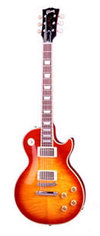Gibson Les Paul
|
|
The Gibson Les Paul signature model is one of the classic solid-body electric guitar designs. It was developed in the early 1950s, and along with the same era's Fender Stratocaster and Telecaster, has become one of the most enduring and popular musical instrument models in the world.
It was introduced in 1952, and has been out of production only once, in the years between 1960 and 1968, when another design, also initially called the 'Les Paul,' but soon renamed the 'SG', took over temporarily as Gibson's flagship instrument of the kind.
The Les Paul model represented a design collaboration between the fairly stolid Gibson company, under president Ted McCarty, and the pop star, electronics inventor and accomplished jazz guitarist Les Paul. After the debut of the Fender Telecaster series guitars, in 1950, solid-body electric instruments became a craze, and Les Paul was brought in by the company as an innovative and respected figure who had experimented with them on his own. An early hand-built prototype of his, called 'the Log,' was once widely considered the first solid-body Spanish (as opposed to 'Hawaiian,' or lap-steel) guitar ever built, although numerous other prototypes and limited-production models have since resurfaced. Paul had earlier, in 1945 or 46, approached Gibson with this prototype, and had been "shown the door."
Digital_Les_Paul.jpg
The new guitar was to be an expensive, well-made instrument in Gibson's tradition, in response to the plain, bolted-together construction of the Fender guitars. Recollections differ on who contributed what to the design, but Gibson had offered electric hollowbody guitars since the 1930s, and provided at minimum a basic set of design cues. Paul's contributions probably included fitting a maple cap over the mahogany body (for increased density and sustain), and collaborating with the technicians who designed the pickups and hardware. For flash's sake, and to drive the point home that the Les Paul model was a quality instrument, somebody (recollections, again, differ) also specified that it be offered with a gold finish.
The 1952 Les Paul featured two single-coil pickups, and a one-piece, 'trapeze'-style bridge and tailpiece, in which the strings were fitted under, instead of over, a steel stop-bar. It was a very heavy instrument (around 9 pounds), and an expensive one, yet it had phenomenal sustain and a smooth, rich tone.
The guitar had some bugs to be worked out, and subsequent models saw the trapeze tailpiece changed to a standard Gibson design. More advanced pickups were developed and fitted, and the Les Paul soon became a family of guitars—the Standard, Custom, and Deluxe—each with different options and finishes, and a different trim level.
In the 1960s, artists such as Mike Bloomfield and Eric Clapton realized the potential of the late '50s Les Paul guitars (particularly the 1959 model) and gave them wide exposure. These guitars featured the thicker, more sustaining tone of Gibson's "humbucking" pickups (the original units are also known as "PAF" —"Patent Applied For"— pickups). The PAFs were designed by Seth Lover while working for Gibson in 1955, and became a standard design for Gibson and many other companies. After Clapton and Bloomfield, other guitarists quickly jumped on the bandwagon, and over the years 1950s Les Pauls have become some of the most desirable and expensive electric guitars in the world. A 1959 Les Paul in good condition can now easily bring prices between $50,000 and $150,000.
The Les Paul is available today in a baffling array of past and present variants, and has been played by a good portion of the most important guitarists of the past half-century. Les Paul himself still plays his personal Les Paul (which, as an inveterate tinkerer, he has heavily modified over the years) onstage, weekly, in New York City. Paul prefers the 'Studio' variation, with different electronics and a one-piece mahogany body.
An electric bass version also exists, although it is less esteemed by players.
Notable players of the Gibson Les Paul include Jimmy Page, Pete Townshend, Duane Allman, Eric Clapton (in his John Mayall & the Bluesbreakers period), Ace Frehley, Slash, Tom Scholz, Joe Perry, Robert Fripp, Peter Green, Mick Taylor, Zakk Wylde, Peter Frampton, Buzz Osborne, Adam Jones, Steve Jones, Mick Jones and Billy Gibbons.
External links
- Gibson USA's Les Paul front page (http://www.gibson.com/products/gibson/lespaul/index.html)
- Gibson Digital (http://www.gibsondigital.com/)da:Les Paul

